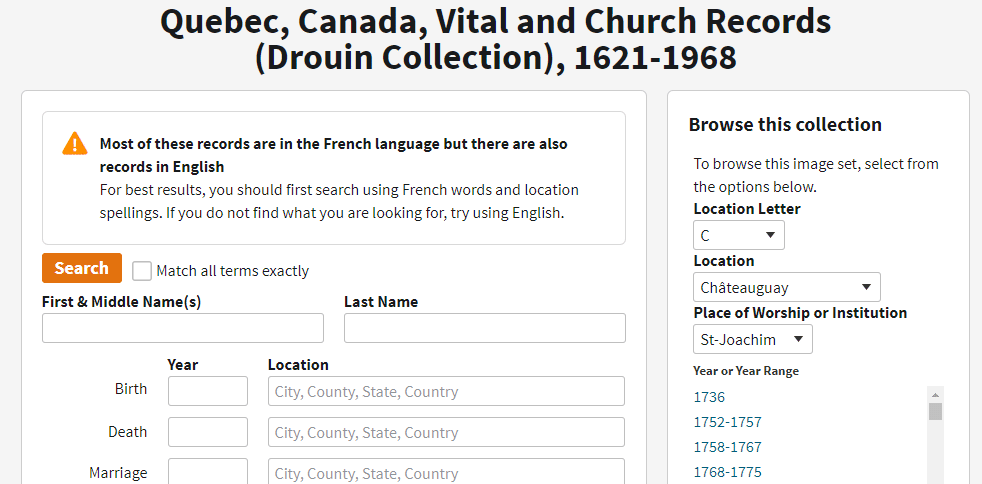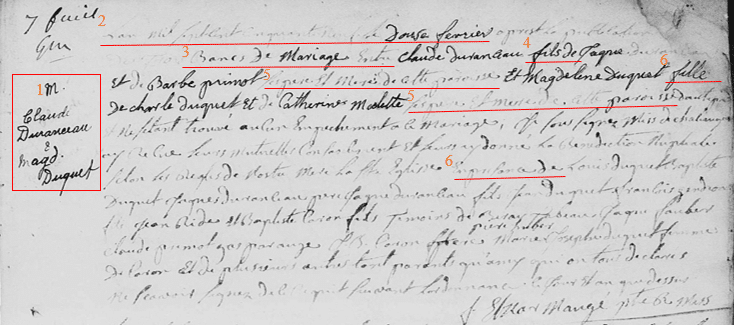Canadian Research Part 3:Tanguay Collection to Drouin and Reading French
 20
20Sep

Now that you have learned how to use the Tanguay dictionary and the Drouin collection, here is an example of how to use them together. Additionally, this post will give you tips on how to read these records even if you do not speak French.
According to information from the Duranceau family entry Claude was:
- born 18 December 1735 in Châteauguay
- married Madeleine Duquet on 12 February 1759 in Châteauguay
Using that information I conducted a search for Claude in the Quebec, Canada, Vital and Church Records, 1621-1968 database on Ancestry. When I searched for Claude Duranceau born in 1735, I only got one result that was a different man. However, when I changed the spelling to Duranseau, I found his burial record. That search provided me with new information: that Claude died on 29 July 1817 and was buried 30 July 1817 in the parish of St Joachim in Châteauguay.
Here are a few tips to help you read Claude’s burial record.
- Many French-Canadian parish registers have marginal notes that indicate the type of record and subject of the record. This can help you quickly look through entries to locate your ancestor. In this entry “S” stands for sépulture, which means burial.
- The date is often written out rather than using Arabic numbers. Use this word list to help you decode the date: 30 July 1817.
- Inhumé means buried. That key word tells you this is a burial record.
- The name of the subject is repeated: Claude Duranseau.
- Décédé means died and is another key word. Sometimes the death date is recorded in the burial record. This record says that Claude “died yesterday,” which means his death date was 29 July 1817.
- Âge means age. This is valuable because you can use it to estimate a birth year. Claude was 82, which means his estimated birth year was 1735.

Even though the index did not help me find Claude’s baptism and marriage records, I could still use the Drouin collection to locate them. Since I had exact dates and locations from the Tanguay dictionary, I used the browse option to find them. As you can see in the image below, the browse section is just right of the search fields. Once you fill it out and click a year range, you can browse those images.

Using the browse feature, I successfully located Claude’s baptism and marriage records which confirmed the information the Tanguay dictionary provided.
Here are a few tips to help you read Claude’s baptism record.
- Remember the marginal note! B stands for baptême, which means baptism.
- The date comes first. In this case the author did use the Arabic numeral 16 for the day, but there’s no year. If you encounter that, look higher on the page or previous pages to determine the year. In this case I determined the year was 1735.
- Baptême means baptism and is a key word for identify baptism records.
- The subject of the record: Claude Durant.
- Né means born and is another key word. Sometimes the priest recorded the birth date in the baptism record. This record says that Claude “was born five days before,” which means his birth date was 11 December 1735.
- “du Mariage de” means of the marriage of. This is a key phrase because it introduces the parents: Jacque Durant Duranceau Brindamour and Marie Barbe Primot.
- “du danger de Mort” means of danger of death. This key phrase indicates a baby was baptized at home because of a high risk of dying.
- Parrain and marrain mean godmother and godfather. In this document the priest did not use those words, but the godparents were Andre Primot and Anne Brunet. You should take note of godparents because they were often family members.

Here are a few tips to help you read Claude’s marriage record.
- Remember the marginal note! M stands for mariage, which means marriage.
- The date is written out again. Use this word list to help you decode the date: 12 February 1759.
- “Bans de mariage entre” means banns of marriage between. Banns (wedding announcements) read in church gave people a chance to object to the marriage. This phrase typically introduces the groom.
- “Fils de” means son of. Here you will get the names of the groom’s parents.
- “Ses pere et mere de cette paroisse” mean his father and mother of this parish. A phrase like this appears for both sets of parents and indicates what parish they live in which can be valuable for tracing a family back to a different area.
- “En presence de” means in the presence of, which is followed by a list of witnesses to the marriage. Each name is often accompanied by an indication of who (bride or groom) they are related to and how. This is a great way to figure out the identities of their uncles, aunts, cousins, and other relatives.

Other Resources
This post provided a brief overview of reading records in French. If you want to further explore reading French records, here list of resources to help you.
- French Genealogical Word List on the FamilySearch Wiki
- The French Script Tutorial created by the Brigham Young University Center for Family History and Genealogy
- Wordreference.com English/French
- Linguee.com English/French
Conclusion
This is part three of a four-part series on French-Canadian genealogy research. It covers several tools that can assist you in seeking your ancestors. Part four explores non-Catholic parish records and the history of jurisdictions in Québec before the creation of Canada in 1867.
Our professional genealogy researchers at Price Genealogy are available to assist you with your French-Canadian research. We would love to verify or extend your Quebecois lines.
by Ariel
Painting: Farquhar McGillivray Knowles, Public domain, via Wikimedia Commons
